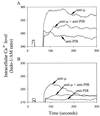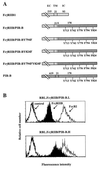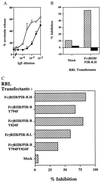The paired Ig-like receptor PIR-B is an inhibitory receptor that recruits the protein-tyrosine phosphatase SHP-1
- PMID: 9482905
- PMCID: PMC19370
- DOI: 10.1073/pnas.95.5.2446
The paired Ig-like receptor PIR-B is an inhibitory receptor that recruits the protein-tyrosine phosphatase SHP-1
Abstract
An emerging family of cell surface inhibitory receptors is characterized by the presence of intracytoplasmic immunoreceptor tyrosine-based inhibition motifs (ITIM). These ITIM-bearing inhibitory receptors, which are typically paired with activating isoforms, associate with Src homology domain 2-containing phosphatases following ITIM tyrosine phosphorylation. Two categories of phosphatases are recruited by the ITIM-bearing receptors: the protein-tyrosine phosphatases, SHP-1 and SHP-2, and the polyphosphate inositol 5-phosphatase, SHIP. The dynamic equilibrium of B cell activation is partially controlled by two well known ITIM-bearing receptors, CD22 and FcgammaRIIB, a low affinity receptor for IgG. We describe here that a murine ITIM-bearing molecule, PIR-B, can also negatively regulate B cell activation. Tyrosine-phosphorylated ITIMs allow PIR-B to associate with SHP-1 but not with SHIP. Engagement of PIR-B thereby initiates a SHP-1-dependent inhibitory pathway that may play an important role in regulating B lymphocyte activation.
Figures




Similar articles
-
Differential roles of N- and C-terminal immunoreceptor tyrosine-based inhibition motifs during inhibition of cell activation by killer cell inhibitory receptors.J Immunol. 1999 Mar 15;162(6):3168-75. J Immunol. 1999. PMID: 10092767
-
SHP-1- and phosphotyrosine-independent inhibitory signaling by a killer cell Ig-like receptor cytoplasmic domain in human NK cells.J Immunol. 2002 May 15;168(10):5047-57. doi: 10.4049/jimmunol.168.10.5047. J Immunol. 2002. PMID: 11994457
-
Effects of Src homology domain 2 (SH2)-containing inositol phosphatase (SHIP), SH2-containing phosphotyrosine phosphatase (SHP)-1, and SHP-2 SH2 decoy proteins on Fc gamma RIIB1-effector interactions and inhibitory functions.J Immunol. 2000 Jan 15;164(2):631-8. doi: 10.4049/jimmunol.164.2.631. J Immunol. 2000. PMID: 10623804
-
Mast cell regulation via paired immunoglobulin-like receptor PIR-B.Immunol Res. 2002;26(1-3):191-7. doi: 10.1385/ir:26:1-3:191. Immunol Res. 2002. PMID: 12403357 Review.
-
Cytoplasmic protein tyrosine phosphatases SHP-1 and SHP-2: regulators of B cell signal transduction.Curr Opin Immunol. 2000 Jun;12(3):307-15. doi: 10.1016/s0952-7915(00)00092-3. Curr Opin Immunol. 2000. PMID: 10781410 Review.
Cited by
-
Functional Roles of the IgM Fc Receptor in the Immune System.Front Immunol. 2019 May 3;10:945. doi: 10.3389/fimmu.2019.00945. eCollection 2019. Front Immunol. 2019. PMID: 31130948 Free PMC article. Review.
-
Activation of immune signals during organ transplantation.Signal Transduct Target Ther. 2023 Mar 11;8(1):110. doi: 10.1038/s41392-023-01377-9. Signal Transduct Target Ther. 2023. PMID: 36906586 Free PMC article. Review.
-
Expression of PirB in normal and injured spinal cord of rats.J Huazhong Univ Sci Technolog Med Sci. 2010 Aug;30(4):482-5. doi: 10.1007/s11596-010-0453-1. Epub 2010 Aug 17. J Huazhong Univ Sci Technolog Med Sci. 2010. PMID: 20714874
-
Leukocyte Immunoglobulin-Like Receptors (LILRs) on Human Neutrophils: Modulators of Infection and Immunity.Front Immunol. 2020 May 13;11:857. doi: 10.3389/fimmu.2020.00857. eCollection 2020. Front Immunol. 2020. PMID: 32477348 Free PMC article. Review.
-
CAMKs support development of acute myeloid leukemia.J Hematol Oncol. 2018 Feb 27;11(1):30. doi: 10.1186/s13045-018-0574-8. J Hematol Oncol. 2018. PMID: 29482582 Free PMC article.
References
-
- Vivier E, Daëron M. Immunol Today. 1997;18:286–291. - PubMed
-
- Burshtyn D N, Yang W, Yi T, Long E O. J Biol Chem. 1997;272:13066–13072. - PubMed
-
- Scharenberg A M, Kinet J-P. Cell. 1996;87:961–964. - PubMed
-
- Alley, T. L., Cooper, M. D., Chen, M. & Kubagawa, H. (1998) Tissue Antigens 51, in press. - PubMed
Publication types
MeSH terms
Substances
Grants and funding
LinkOut - more resources
Full Text Sources
Other Literature Sources
Molecular Biology Databases
Miscellaneous

